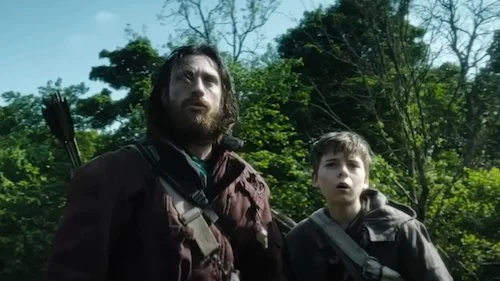28 Years Later
Written by Andreas Babiolakis
Warning: This review contains minor spoilers for 28 Years Later. Reader discretion is advised.
“We're trapped in the belly of this horrible machine and the machine is bleeding to death.”
• From ”Dead Flag Blues” by Godspeed You! Black Emperor
28 Days Later is now twenty three years old. Much has happened to solidify director Danny Boyle and screenwriter Alex Garland’s horror film a masterpiece of the genre, from the outbreak of zombie films and series in its wake (most of which don’t even come close in quality or purpose), to the prophetic nature of the motion picture in hindsight (the divide of the world, the COVID-19 pandemic, numerous economic collapses, and major sociopolitical hostility). In 28 Days Later, Boyle and Garland had us confront the inevitable if such a predicament ever became true: do we kill a loved one if they are now infected? Are we putting them out of their misery, or is terminating their life early unforgivable no matter the circumstance? This humanization of the undead and/or infected set a precedent for the zombie genre, ultimately leading to the occasional triumph like Naughty Dog’s unparalleled video game, The Last of Us and its sequel; outside of these two examples, most imitators missed the balances that make 28 Days Later special. You cannot understand the pains of society without seeing the beauty of nature; you miss the devastation of humanity’s downfall when you forget that these are all intended to be real people with different dreams and trajectories cut short via this curse; we cannot see the parallels between our daily lives and post-apocalyptic storytelling if we only focus on zombie tropes.
As mentioned, so much has transpired since 28 Days Later that Boyle and Garland are back (I’m skipping over the so-so sequel 28 Weeks Later which had barely any involvement from either filmmaker) with 28 Years Later. For better or for worse, 28 Years Later is far more interested in what is happening in our world today than the first film in the series which was concerned with what could happen. Naturally, we cannot escape the damnation we face on a regular basis, whereas 28 Days Later was released after the turn of the twenty-first century and the new millennium: we still looked ahead with promise and large, sparkling eyes. We’re not quite as optimistic as we once were, to say the least. Thus, 28 Years Later had to be more rooted in political commentary. This does prevent the film from exploring introspective dilemmas and the bittersweet nature of civilization crumbling while nature heals as much as 28 Days Later does. 28 Years Later also feels a bit constrained to a series of premises as opposed to a fully developed story, seeing as each each plot pivot feels more like an analytical checkpoint of the near future as opposed to a proper continuation of the narrative at hand. However, this occasionally works as the best moments of 28 Years Later achieve what makes 28 Days Later such a success, although not nearly as frequently: a new perspective on overcooked conventions.
28 Years Later begins roughly where the very first film commenced: amidst the initial outbreak. In typical Boyle fashion (he loves tossing in his pop culture references), we see children watching Teletubbies which acts not just as a chronological bookmark but as a contrast of how we once viewed the future (one full of life, joy, and green nature and blue skies). After a group of people infected by the Rage Virus rip apart the party, a sole survivor — a child named Jimmy — finds safety within a church with a vicar who insists that the outbreak is a sign of the end times. We then cut to twenty eight years later and meet a family consisting of scavenger Jamie (Aaron Taylor-Johnson), his wife Isla (Jodie Comer), and their son Spike (Alfie Williams). They live on Holy Island in a community that is seen as protected from any potential infected due to a quarantine that has yet to be lifted (clearly mirroring the isolation we experienced during the 2020 pandemic and, depending on the person and location, onward).
Much uncertainty arises when Spike is taken on a hunt to mark that he is becoming a man, particularly when he and his father come across a seemingly new variant of infected that they have to escape. Seeing as one member of the pack is branded with the name “Jimmy” (no coincidence here, I’m sure), and a bonfire nearby is attributed to an urban legend that the isolated Dr. Ian Kelson (Ralph Fiennes) burns bodies as a religious ritual, the question of where these infected people came from begins to form. Thus begins the blame game: something we are far too used to in everyday life via the entrapment of social media. That unity that 28 Days Later once instructed is all but gone here, sadly understandably so. To make a film where people work together in the face of adversity won’t get us through the tough times of late.
28 Years Later is a little uneven as a whole, but it does exhibit moments of true greatness.
Without going into the film too much more, I did find 28 Years Later rather uneven, seeing as most of the film is quite good but a little thin in terms of what it is trying to say — whereas certain sequences are honestly phenomenal and show what Boyle and Garland chased after when manifesting this film. These include (without blatant spoilers) looks at other types of illnesses amidst outbreaks, the act of bringing life into a world of hatred and demise, and the intention of finding hope within death via tributes and practices. It is through these devices that Boyle and Garland are able to make each infected person feel like a living being who has been forever changed by a virus, and — as they did in 28 Days Later — each life matters. The sadness of a worldwide plague is felt again, and the different ways people survive, reflect, and celebrate being alive gave me goosebumps every time something new was shown.
In between these flashes of greatness are slight bouts of tonal confusion, where — and this is highly unusual for the duo — Boyle and Garland almost didn’t feel like they were on the same page. When Garland wants a slow-burning moment of realization, Boyle leaps to quickly-cut panic. Where Boyle finds an opportunity to become enveloped with familial drama, Garland tries to seize the moment with definitive lines of dialogue that don’t have to conclude scenes as early as they do. These conflicts are few and far between, but I do feel as though both filmmakers differed slightly with how they felt 28 Years Later should go; either as a pensive, poetic look at how society can change after an outbreak, or as a tense wake-up call that the virus will likely never end and no one will be safe again. When the two visionaries connect, 28 Years Later is magnificent. However, they don’t always this time around.
Case in point: the return of the song “East Hastings” by Canadian post-rock band Godspeed You! Black Emperor (who never allow films or series to use their music aside from one particular exception). In 28 Days Later, “East Hastings” starts the film off as the character Jim leaves a hospital and notices that London is now a ghost town void of any signs of life. East Hastings is a section of Downtown Vancouver, Canada that is highly impoverished and where many homeless and drug-addicted people struggle on the floors and walls of what was once meant to be an area of prosperity; to look at East Hastings with my own eyes was to see how society fails its people. I understood Godspeed You! Black Emperor’s song better than I have ever before as it provides a soundtrack to this desperation: as if there is no way out of this. 28 Days Later mirrors this suffering and the red flags of a doomsday caused by human error. When the song “East Hastings” is used in 28 Years Later, it is at the end of the film and as a means of heightening an action sequence. While the escalating crescendos ring true to the excitement of the scene, the deeper consideration of how far humanity has come — to the point of self-implosion — that feels a little lost. 28 Years Later quickly follows up this scene with what I believe is an extreme metal version of the Teletubbies theme song (first off, yes, I am serious, and, secondly, it may make more sense in context). It’s this kind of ADHD-infused decision making that leads me to believe that not a full picture of what Boyle and Garland wanted to say with 28 Years Later was ever present. Those moments where the stars align, however, are like lightning striking the same post by some sheer miracle.
Andreas Babiolakis has a Masters degree in Film and Photography Preservation and Collections Management from Ryerson University, as well as a Bachelors degree in Cinema Studies from York University. His favourite times of year are the Criterion Collection flash sales and the annual Toronto International Film Festival.






